Ads on e-blasts pick up an easy $30,000 for Herald-Mail
Media: Herald-Mail with 30,000 circulation, and an email database 22,500
Key executive: Liz Thompson, digital director, Herald-mail and Director of Center for Excellence for database and email marketing, Schurz Communications.
Challenge: In 2011, Schurz Communications, Inc. (SCI) - owner of a couple of dozen newspapers and broadcast sites - decided to build-out its email databases throughout the company. "We have email, but we don't always know, as a company, what to do with it," Thompson said.
While Schurz has daily deals driven by email, executives realized that email itself was a asset with ancillary value as a brand advertising medium.
"We recognized the value of having robust databases made up of people who opted-in. 1000 people who have said I want to know about dining and food are far more valuable to restaurants than 10,000 people if you are not real sure what their interests are."
Additionally, e-mail is something that everyone gets, and "gets," including merchants who are more than willing to pay to participate in a targeted blasts in which they have great brand display visuals. Especially when readers have opted-in, ads on emails are more prominent, personal and targeted than on banners on web sites.
However, there are a number of upfront obstacles: First and foremost, getting the display ads onto the emails, plus being able to get the right opt-ins. Additionally each of two dozen local media properties had their own email plan, with some great ideas, but at widely differing paces and strategies. Overall, growth in the database was too slow. The challenge was to create a companywide email strategy that would allow each media to monetize its new audiences.
Strategy: To leverage assets and share core skills, the company needed an overall plan.
1. Move to one platform. The first step was to move all the properties on to one platform. Regardless of the vendor, a centralized platform had the advantages of acquiring a shared knowledge base and company asset. “As we are gathering information, we are also creating a corporate database.”
2. Select a vendor. In order to fully leverage email marketing, SCI needed a vendor with robust capabilities that included multiple templates to create visually appealing newsletters, state of the art tracking, and integration with Dart For Publishers (DFP) their ad serving software.
A key to success was the selection of Presslaff Interactive, which has built in templated ads and email opt-in forms. Another key factor was their expertise in revenue generation and marketing, Thompson said. "Their people work directlyw with us to develop marketing and advertising strategies."
3. Center for Excellence for Database and Email marketing
A centralized approach to sharing best practices and minimum requirements, meant creating a Center for Excellence for Database and Email marketing, inside the company, and run by a digital marketing department inside one of the most active properties. Thompson was appointed to head up the iniative.
4. Establish overall requirements for all markets
One of the first initiatives of the Center was to establish some minimal requirements for database development across all of the properties, including programs that would touch the whole database on a regular basis.
Emails thus need to be acquired from all sources: Subscriptions, advertisers, classifieds, online website sign ups. There were two primary types of emails that all markets would send out:
a. Promotional emails
All markets are encouraged to have a promotional program. The Herald-Mail sends out a monthly VIP Insite Club e-mail to the entire Herald Mail database of 22,000, including contests, promotions, events and other information.
The second promotional email at the Herald mail is sent twice a month and is sold to advertisers, although they also include information about out own contests and promotions. The three to five advertisers, each of whom pays $175 for the opportunity to reach the database of just 2,200 twice a month.
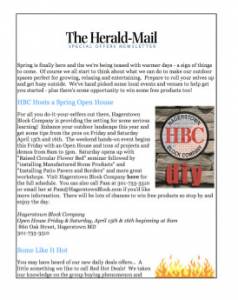
b. Readership and or audience development programs
Print markets typically have two email newsletters: Breaking news and
"tomorrow's headlines today," the top five stories auto-generated via the newspapers CMS. Television and radio can focus on weather and sports. Here is a breakdown of all the areas that could be tapped:
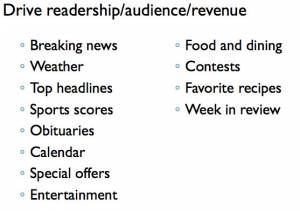
5. Create identical registration pages with 20 e-mail opt-in choices
All sites have the same basic registration page, asking visitors to check all of the 20 categories they are interested in receiving information about.
Here's the new set of pages:
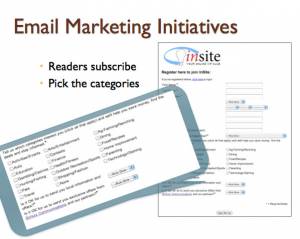
In the second stage of registration on Presslaff, you will go to a page that looks not unlike this (fromer version) to sign up for newsletters:

6. Launch advertising products inside promotional and news related emails
Even with small databases, local markets are selling a number of ads directly on targeted emails. Different markets were allowed to experiment with a variety of promotions. Here are some examples of types of products in the mix across several markets:
*Happy Birthday emails
One of the stars in email marketing, Bloomington, Indiana, run by Brooke McCuskey, marketing manager, used the email system will automate happy birthday greetings from the required field. With a 57% open rate, this email is popular with advertisers.
"One things we push is for advertisers to give a gift," Thompson says. This can be anything from a cupcake, cookie or free cup of coffee to a discount.
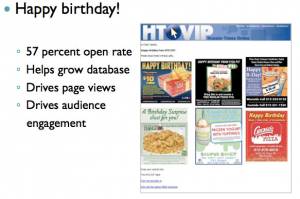
*B2B emails
Once a month a B2B email targets businesses with paid profiles of printers and caterers and hotels. "The message is simply 'here is who we are and how we can help you.”
*Open house emails
An Open House email includes an ad at the top, and since the recipients have signed up for real estate information, realtors are "fighting over the open house banner ad."
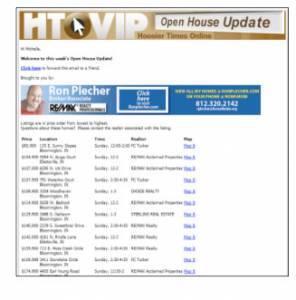
*Obituaries
There are a number of local markets who continue to experiment: Aberdeen South Dakota publishes a daily email with obituaries and links back to the obituaries on the web site.
*News
Ads on news emails are charged via flat fee, since the media does not know how many of these alerts will go out. For $800 a month, local merchants can reach the Herald-mail's core group of 5500 people, in news blast all month long. Below is the weekly round-up followed by the headline news e-blast.
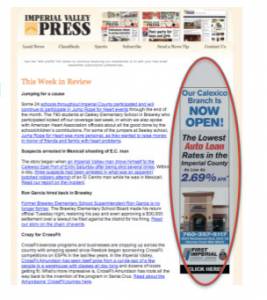
Here's an example of teh Headline News email:
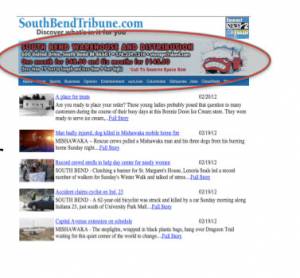
*Promotional emails
The "special offers" mentionned above, goes out twice a month, and includes a business listing, for $175 a month, with three to six exclusive by category positions. These have been selling well, at the Herald and could support a price increase.
*Valentine's Day contest
Then there are the data-gathering - and sponsored - contests, such as Valentine's day, in which advertisers provide a prize such as a coupon, behind online ads promoting "click on" a three question survey to enter to win a dinner for two and a day trip. The Advertiser pays $300 for the ads and email, in addition to donating the prizes. One such contest was for Valentine's day, and featured a local romantic dinner for two. Ads ran to "find the heart" on the web site.
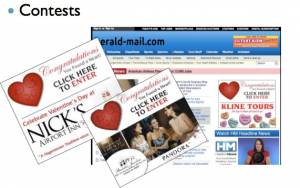
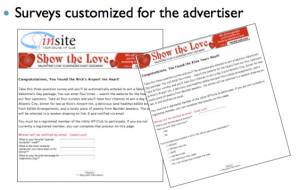
Another contest that built the database - and secured advertiser dollars was the "Ultimate Man Cave contest." Three advertisers donated flat screen tv, a recliner, and catered dinner for ten. Readers were told to look for the log on the site, click the logo to take the survey and eneter a drawing.

Results and summary
The Herald-Mail alone is currently selling about $30,000 a year from email advertising, and one other property has been very aggressive in following suit. Multiple these number by ten to 20 markets and it starts to add up. More importantly, email is easy to bundle and easy to obtain an upsell. Adding display advertising to targetted emails that also generate traffic is just an easy way to avoid leaving money on the table. The most difficult issue maybe how to integrate direct advertising on eblasts with deal programs that also rely on opt-in emails. In some categories it is relatively easy - open houses and breaking news emails don't compete with deals. However, promotional emails include offers and could also promote the deals of the day. Also of note: The key to this program was partnering with an email vendor, PressLaff, that can provide templates and expertise.
Many thanks to Liz Thompson, Digital Director of the Herald-Mail for sharing these tips on how to develop an email strategy - and sell advertising on emails.

The author, Alisa Cromer is publisher of a variety of online media, including LocalMediaInsider and MediaExecsTech, developed while on a fellowship with the Reynolds Journalism Institute and which has evolved into a leading marketing company for media technology start-ups. In 2017 she founded Worldstir.com, an online magazine, to showcases perspectives from around the world on new topic each month, translated from and to the top five languages in the world.









